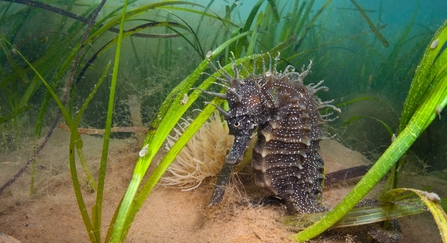Seagrass is exactly as it sounds – grass that lives in the sea! Like grass that grows on land, when allowed to flourish seagrass creates beautiful meadows of llush green in the shallower water of our shores, where fish and crustaceans of all shapes and sizes find shelter.
Watching the long, vivid stems flow back and forth in the ocean currents, as grassland meadows dance in soft summer breezes, is a mesmerising sight. Seagrass is an important underwater habitat in shallow seas, providing shelter for many species including seahorses and pipefish. But, like our precious peatlands, seagrass has further benefits, particularly in the fight against the climate emergency.
Seagrass typically grows in dynamic coastal areas and slows down the strength of strong waves and currents. This in turn creates a more stable environment in which other habitats can establish - such as saltmarsh, a highly biodiverse environment that is also in decline.
As the climate emergency causes our weather to become more violent, we can view seagrass as our first line of defence in helping stabilise the shoreline.
Underwater carbon store
Seagrass is also a magnificent carbon store. Not just in the plant itself, as seagrass can also lock carbon away under the sediment. In fact, 10% of global ocean carbon consumption is taken up by seagrass every year, even though it only accounts for 0.2% of the ocean floor!
Sadly, seagrass is a struggling species. In the UK alone, we have lost around half of our seagrass in the past 35 years. This is due to a variety of factors including disease, pollution and coastal development.
There are only two seagrass populations in Yorkshire, one of which is at our Spurn National Nature Reserve.


